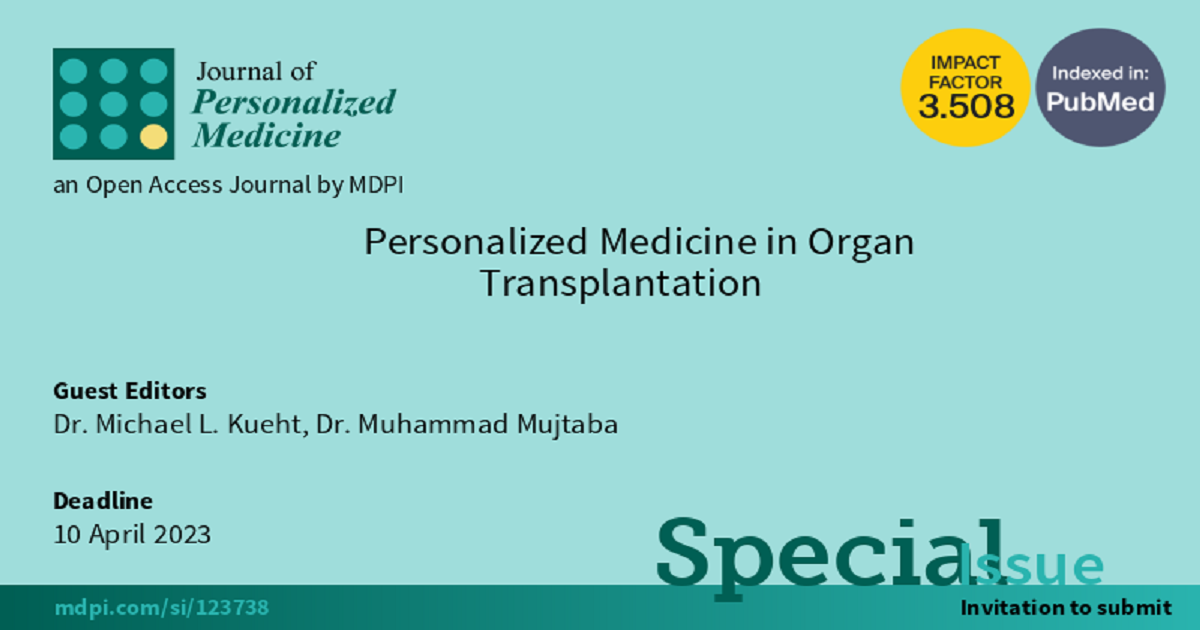Personalized Medicine in Organ Transplantation
A special issue of Journal of Personalized Medicine (ISSN 2075-4426). This special issue belongs to the section "Clinical Medicine, Cell, and Organism Physiology".
Deadline for manuscript submissions: closed (5 October 2023) | Viewed by 16915

Special Issue Editors
Interests: kidney transplantation; transplant surgery; organ transplantation; organ donation; transplant immunology; chronic liver failure; liver transplantation; graft survival; liver cell carcinoma
Interests: kidney transplantation; transplant surgery; organ transplantation; organ donation; transplant immunology; transplant medicine
Special Issue Information
Dear Colleagues,
Since the first successful human-to-human kidney transplant between identical twins in 1954, personalized medicine has permeated the field of transplantation due to the intricacies of donor-recipient matching. Indeed, transplantation has been nearly synonymous with personalized medicine, requiring specialized approaches to ABO blood typing, HLA classification, infectious disease treatment and prophylaxis, medication dosing, and surgical techniques. In the current era of precision medicine initiatives, the field of transplantation is ripe for innovation that is accelerating at a pace akin to Moore’s Law. Practitioners in the field are constantly striving to provide the best possible care for patients in the context of shifting multi-level regulations and an urgency to meet the increasing demands for transplantable organs. Despite the progress, solutions to ongoing problems remain elusive, such as equitable allocation policies, pre-transplant risk assessment, optimal induction and maintenance immunosuppression regimens, and intelligent allograft monitoring protocols. All these and more are needed to ensure improved allograft and patient survival while minimizing the risk of infectious and other complications.
This Special Issue of the Journal of Personalized Medicine aims to highlight some of the latest studies applying precision medicine to improve the care of people with end stage organ disease who are in need of or have undergone transplantation.
Dr. Michael L. Kueht
Dr. Muhammad Mujtaba
Guest Editors
Manuscript Submission Information
Manuscripts should be submitted online at www.mdpi.com by registering and logging in to this website. Once you are registered, click here to go to the submission form. Manuscripts can be submitted until the deadline. All submissions that pass pre-check are peer-reviewed. Accepted papers will be published continuously in the journal (as soon as accepted) and will be listed together on the special issue website. Research articles, review articles as well as short communications are invited. For planned papers, a title and short abstract (about 100 words) can be sent to the Editorial Office for announcement on this website.
Submitted manuscripts should not have been published previously, nor be under consideration for publication elsewhere (except conference proceedings papers). All manuscripts are thoroughly refereed through a single-blind peer-review process. A guide for authors and other relevant information for submission of manuscripts is available on the Instructions for Authors page. Journal of Personalized Medicine is an international peer-reviewed open access monthly journal published by MDPI.
Please visit the Instructions for Authors page before submitting a manuscript. The Article Processing Charge (APC) for publication in this open access journal is 2600 CHF (Swiss Francs). Submitted papers should be well formatted and use good English. Authors may use MDPI's English editing service prior to publication or during author revisions.
Keywords
- organ transplantation
- personalized medicine
- precision medicine
Benefits of Publishing in a Special Issue
- Ease of navigation: Grouping papers by topic helps scholars navigate broad scope journals more efficiently.
- Greater discoverability: Special Issues support the reach and impact of scientific research. Articles in Special Issues are more discoverable and cited more frequently.
- Expansion of research network: Special Issues facilitate connections among authors, fostering scientific collaborations.
- External promotion: Articles in Special Issues are often promoted through the journal's social media, increasing their visibility.
- e-Book format: Special Issues with more than 10 articles can be published as dedicated e-books, ensuring wide and rapid dissemination.
Further information on MDPI's Special Issue polices can be found here.







